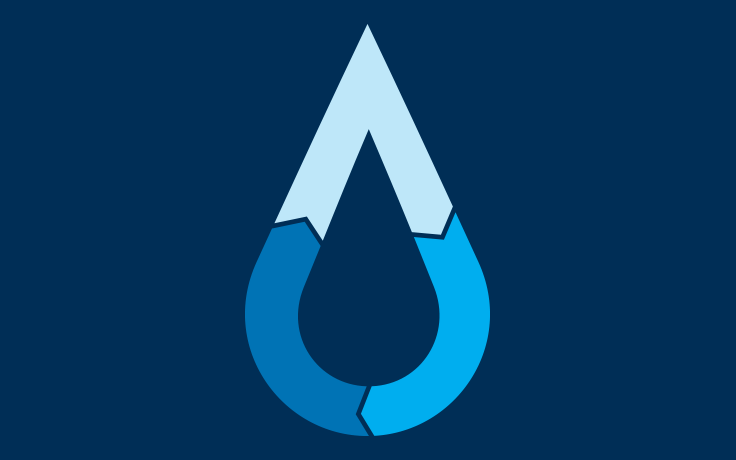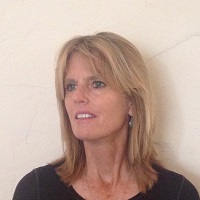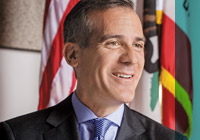IT STARTED IN THE SHOWER. Eric Hoek was 11. He noticed that the water smelled. The odor was strangely sweet.
His father, a conservation biologist and ecology professor at Rutgers, and others in their community soon discovered why. The well supplying water to their New Jersey neighborhood — indeed, the entire aquifer — had been contaminated by toxic waste. It was life-altering.
In personal ways. “We couldn’t take showers or drink the water for a couple of months,” Hoek said. “Obviously, we showered. But we had to haul water in, because exposure is bad. It absorbs through your skin.”
And in public ways. The municipal water and sewer provider solved the problem; and the experience, in the 1980s, left its mark. From then on, whenever Eric M.V. Hoek saw dirty water, he looked for ways to clean it. Water has always been a part of his life’s work.
“I’m a membrane guy”
Hoek, 44, now has two small children of his own. He attended Penn State for a bachelor’s degree in civil and environmental engineering, then UCLA for his master’s, and finally Yale for a doctorate in chemical and environmental engineering. After teaching at UC Riverside, he came to UCLA in 2004 as a professor of environmental engineering. He co-founded UCLA’s Water Technology Research Center and has studied water treatment for 20 years, using membranes to filter out impurities, including microfiltration, ultrafiltration, nanofiltration and reverse osmosis, in which water passes through pores smaller than a nanometer — or less than one billionth of a meter.
In 2005, his inventions helped create NanoH20, now LG Water Solutions, which makes Quantum Flux reverse osmosis membranes. He also founded NanoMem Consulting, a nanotech membrane water consultancy company. In 2009, he was introduced to actor Kevin Costner, who had been inspired by the Exxon Valdez oil spill to invest in Department of Energy centrifugal technology that separates oil and water. Costner asked Hoek to explore other uses.
“I am a membrane guy,” he told Costner, “so I will see what it can do.”
Hoek’s lab tests showed that the centrifuge was capable of restoring water to 99.9 percent purity, and he designed a special membrane to filter out the last few parts per million of oil.
In April of 2010, British Petroleum’s Deepwater Horizon oil rig exploded in the Gulf of Mexico, killing 11 people. Oil gushed from the sea floor for 87 days, creating the largest ocean oil spill in history. Hoek, by now a consultant to Costner’s Ocean Therapy Solutions, which was later renamed Blue Planet Solutions, flew to the gulf with a restoration team.
Sunshine was baking the oil, and waves were mixing it with chemical dispersants and natural organic matter. During a test, the emulsion “had a viscosity like peanut butter,” Hoek told the Guardian, and it couldn’t be pumped from skimmers onto vessels equipped with Ocean Therapy’s centrifuges. “In real-time, during the spill clean-up efforts, we learned how to apply emulsion-breaking chemicals,” Hoek recounted in an email to Blueprint. British Petroleum bought more than two dozen of the centrifuges. On some days, the water was too “full of sticks or peanut butter,” he told the Guardian, but on others, the pumps could deliver it. “I can’t think of a case,” Hoek told Blueprint, “where we couldn’t process the recovered materials after applying some emulsion-breaking chemicals.”
“It was a very interesting experience for me to get out of the lab and to have to solve real engineering problems where you are in the middle of a crisis,” he said. When he returned to UCLA, Hoek said, he solved the oil-water viscosity problem completely. Although the New Yorker, in a lengthy account of the gulf disaster, said Ocean Therapy’s centrifuge system had been “impractical for this spill,” a report by British Petroleum called it a success. Centrifuge technology, Hoek said, is one of the most important contributions to oil-spill response in the past 20 years.
Converting wastewater
In 2011, Costner and another investor offered Hoek the backing to start a company of his own. Hoek closed NanoMem Consulting and created Water Planet, Inc. It has grown from three to 20 employees in five years. His timing could not be better. Saving and recycling water is California’s most pressing mission as the state’s drought enters its fifth consecutive year.
Water Planet’s mission is to treat the most stressed and difficult wastewater. Hoek and his team specialize in “polishing” water produced by oil and gas companies during petroleum extraction. Industrial WaterWorld, a publication that reports on managing industrial water usage, says billions of gallons of contaminated water are produced every year in the Bakersfield area alone, which could be cleaned and used in industrial processes, agricultural rinsing and irrigation. Hoek sees a mutually beneficial relationship between oil companies and farmers: Oil companies need to dispose of vast quantities of wastewater, and farmers need vast amounts of water to grow crops and rinse down their operations.
Plants in Wasco and Lost Hills, using Water Planet technology, are expected to recycle a total of 4 million gallons of water a day at their peak. Frances Spivy-Weber, a member of the California Water Resources Control Board, said Water Planet cleans wastewater to a “high quality,” better than many of its competitors. Dundee Kelbel, manager of Sweetwater Tech Resources, a Tucson-based treatment company that uses Water Planet at Wasco and Lost Hills, says 90 percent of dirty effluent is treated to three levels: clean, cleaner and cleanest. Clean water goes back to oil companies for reuse. Cleaner water goes to farmers for rinse-down operations. Farmers use the cleanest water to irrigate.
“The water cleanliness needs to match or exceed the regulation quality of ground irrigation water,” Kelbel said. “That is the stuff growers would normally get from water storage districts or California aqueducts. Our target is to beat that, so the end result is water that would improve the overall quality of ground irrigation. Water Planet’s technology has the ability to treat for that level and exceed it.”
At present, produced water is a largely untapped resource. Jonathan Bishop, chief deputy director of the Water Control Resources Board, said the extraction of one gallon of oil produces about 10 gallons of wastewater. Very little of it is treated to regulation standards and being recycled, Bishop said. “Hazarding a guess, I would say less than 5%. We would like to see more of that.” Most of the rest of oil- and gas-produced wastewater is injected into deep, salty aquifers. Some is used for more oil extraction. A small percentage is dumped into ponds where solid waste settles and the water evaporates, leaving a sludge that is hauled away for disposal in designated landfills.
“There are all sorts of things pushing oil and gas companies to have more reuse,” Bishop said. “The rules are more stringent for disposal now. As the price of water goes up, the relative price of water reuse goes down. A need and desire for industry to clean wastewater looks better and better.”
Certainly treating wastewater is essential in edging California closer to a more sustainable water management strategy. “Recycling and reusing industrial wastewater is ultimately about preserving fresh water resources for the drinking water supply, instead of using fresh water for industrial uses like dust suppression, which you can use reclaimed wastewater for,” Hoek said. “We can typically treat industrial water to very high levels for less than it would cost to dispose of it, or to purchase new fresh water.”
New technology changing the game
Two and a half years ago, Hoek left UCLA to devote his full attention to Water Planet. The company has just introduced award-winning technology and a new membrane. He says they are “game changers.”
The technology, called IntelliFlux®, is an artificial intelligence software control and automated treatment system that performs at peak efficiency — nearly impossible to maintain under human supervision. It is expected to reduce the cost of energy, labor and chemicals. In April, IntelliFlux® and Water Planet won the Water Technology Idol Award at the Global Water Awards.
The membrane, called PolyCera®, was developed in collaboration with UCLA scientist Richard Kaner. It is a hydrophilic, permeable skin that acts like a ceramic but has the durability and lower cost of a polymer. With fellowship funding and a $50,000 award from the National Water Research Institute, the membrane was developed in Kaner’s lab. He won the Materials Research Society Medal (2015) for his work, including the development of PolyCera® membranes used by Water Planet.
“We have two patents pending on the AI (artificial intelligence) algorithms and another on the hardware design (IMS-5000) being used in a range of applications in oil and gas process and produced water recycling,” Hoek said in an email. Water Planet has licensed nine patents from UCLA, including the patent for PolyCera®, which was tested at a site in Texas so remote that there was no fresh water and no infrastructure for wastewater treatment. The super-membrane cleaned wastewater successfully, and the water was reused in industrial processes.
“Everything that we do kind of fits into this category,” Hoek said. “Reclaim some part of the waste so that you are minimizing fresh water that otherwise would be used for drinking.”
Water Planet is conducting three pilot studies at a wastewater treatment plant for a Southern California water district. Hoek did not identify the water district. “It is about protecting our (intellectual property) and data,” he said. “Our team wants to keep it quiet until after we are finished.” The studies are expected to be completed in October. The goal is to help the district meet state reuse standards and to improve efficiency, cost and water purity.
“Our expectation,” Hoek wrote in an email, “is that having smaller pore size but higher permeability offers better water quality than state of the art. From these tests, we will develop more unassailable data demonstrating the energy, chemical and cost reductions due to PolyCera® alone, IntelliFlux® alone and combined.”
Time will tell. If the district likes the results, Water Planet will be on the map in Southern California. For Hoek, it is satisfying to see his fledgling company grow into a successful corporation. But what Hoek does is more than a business. Saving water, for him, is a way of life.
Correction: October 11, 2016
This article has been revised to reflect the following correction: An earlier version stated inaccurately that Richard Kaner won the Nobel Prize in chemistry. He is the recipient of many other awards, including the Materials Research Society Medal (2015).

























